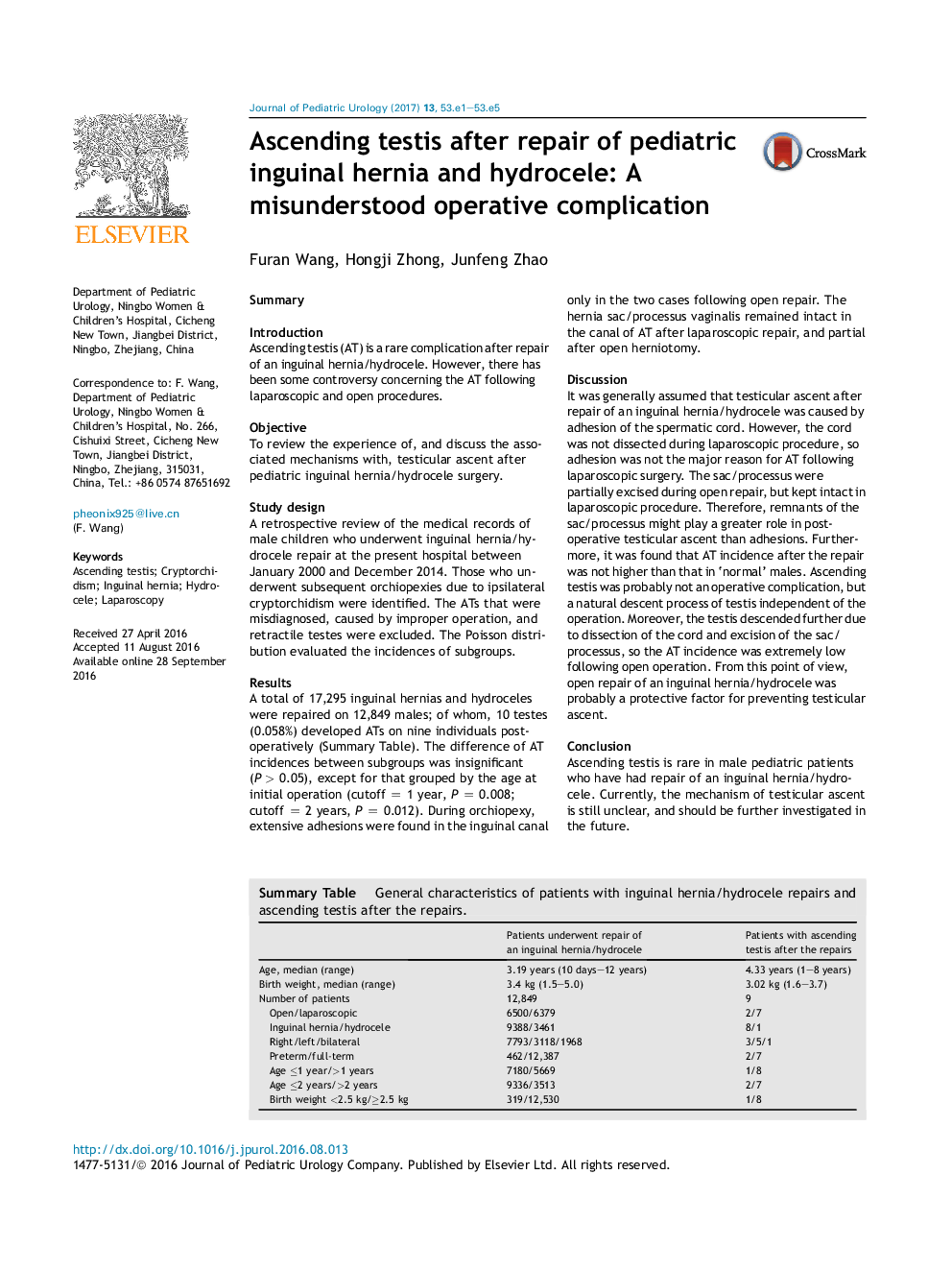| کد مقاله | کد نشریه | سال انتشار | مقاله انگلیسی | نسخه تمام متن |
|---|---|---|---|---|
| 5718657 | 1411255 | 2017 | 5 صفحه PDF | دانلود رایگان |
SummaryIntroductionAscending testis (AT) is a rare complication after repair of an inguinal hernia/hydrocele. However, there has been some controversy concerning the AT following laparoscopic and open procedures.ObjectiveTo review the experience of, and discuss the associated mechanisms with, testicular ascent after pediatric inguinal hernia/hydrocele surgery.Study designA retrospective review of the medical records of male children who underwent inguinal hernia/hydrocele repair at the present hospital between January 2000 and December 2014. Those who underwent subsequent orchiopexies due to ipsilateral cryptorchidism were identified. The ATs that were misdiagnosed, caused by improper operation, and retractile testes were excluded. The Poisson distribution evaluated the incidences of subgroups.ResultsA total of 17,295 inguinal hernias and hydroceles were repaired on 12,849 males; of whom, 10 testes (0.058%) developed ATs on nine individuals postoperatively (Summary Table). The difference of AT incidences between subgroups was insignificant (P > 0.05), except for that grouped by the age at initial operation (cutoff = 1 year, P = 0.008; cutoff = 2 years, P = 0.012). During orchiopexy, extensive adhesions were found in the inguinal canal only in the two cases following open repair. The hernia sac/processus vaginalis remained intact in the canal of AT after laparoscopic repair, and partial after open herniotomy.DiscussionIt was generally assumed that testicular ascent after repair of an inguinal hernia/hydrocele was caused by adhesion of the spermatic cord. However, the cord was not dissected during laparoscopic procedure, so adhesion was not the major reason for AT following laparoscopic surgery. The sac/processus were partially excised during open repair, but kept intact in laparoscopic procedure. Therefore, remnants of the sac/processus might play a greater role in postoperative testicular ascent than adhesions. Furthermore, it was found that AT incidence after the repair was not higher than that in 'normal' males. Ascending testis was probably not an operative complication, but a natural descent process of testis independent of the operation. Moreover, the testis descended further due to dissection of the cord and excision of the sac/processus, so the AT incidence was extremely low following open operation. From this point of view, open repair of an inguinal hernia/hydrocele was probably a protective factor for preventing testicular ascent.ConclusionAscending testis is rare in male pediatric patients who have had repair of an inguinal hernia/hydrocele. Currently, the mechanism of testicular ascent is still unclear, and should be further investigated in the future.Summary Table. General characteristics of patients with inguinal hernia/hydrocele repairs and ascending testis after the repairs.Patients underwent repair of an inguinal hernia/hydrocelePatients with ascending testis after the repairsAge, median (range)3.19 years (10 days-12 years)4.33 years (1-8 years)Birth weight, median (range)3.4 kg (1.5-5.0)3.02 kg (1.6-3.7)Number of patients12,8499 Open/laparoscopic6500/63792/7 Inguinal hernia/hydrocele9388/34618/1 Right/left/bilateral7793/3118/19683/5/1 Preterm/full-term462/12,3872/7 Age â¤1 year/>1 years7180/56691/8 Age â¤2 years/>2 years9336/35132/7 Birth weight <2.5 kg/â¥2.5 kg319/12,5301/8
Journal: Journal of Pediatric Urology - Volume 13, Issue 1, February 2017, Pages 53.e1-53.e5
